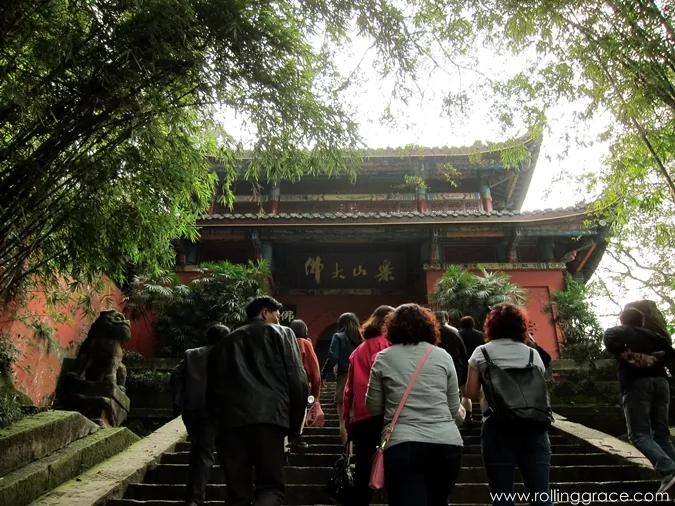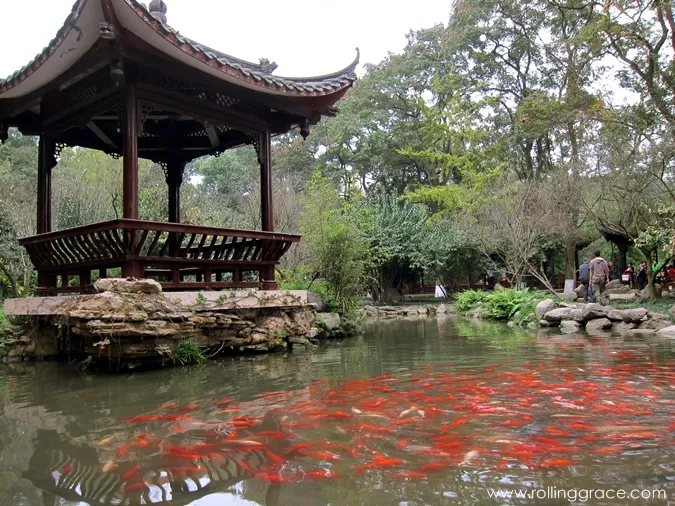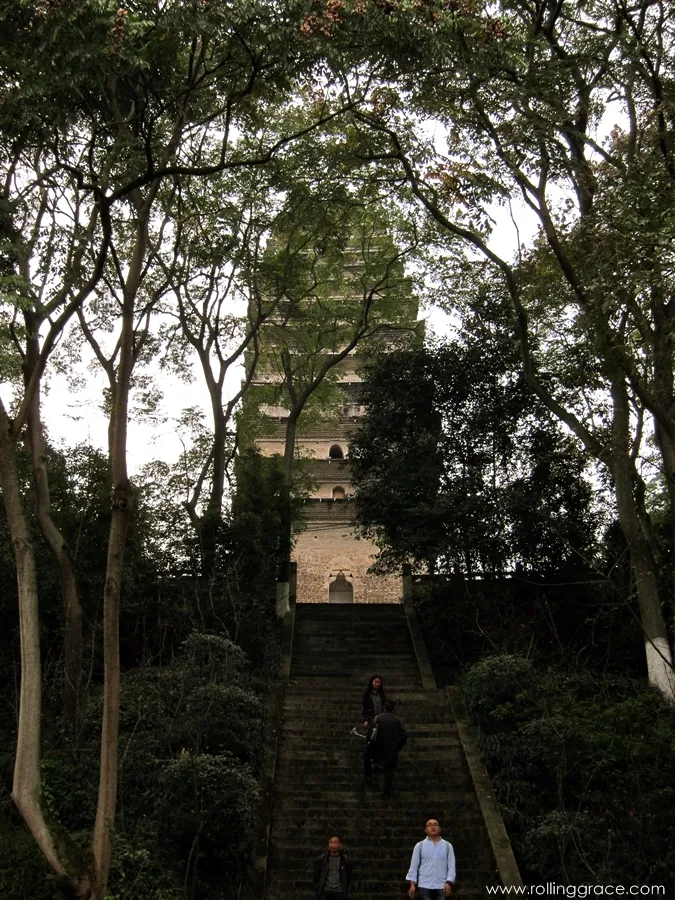Top Attractions in Leshan, Sichuan
Leshan Giant Buddha
The biggest reason for tourists traveling to Leshan is to witness the grandeur of the Leshan Giant Buddha. The stone statue is 71-metre in height and was built during the Tang Dynasty in year 713. It is carved out of a cliff, facing the junction of the Qingyi, Dadu and Minjiang rivers in the Southern Sichuan basin. Leshan Giant Buddha is the largest stone Buddha in the world and is also claimed to be the tallest pre-modern statue ever built. It was listed as the UNESCO World Heritage Site in 1996.
Entrance Fee to Leshan Giant Buddha
Entrance fee to the Leshan Giant Buddha is ¥90.
Touring the entire Leshan Giant Buddha site might take up to 6 hours, depending on the crowd and how much you can walk.
 |
The famous Leshan Giant Buddha is aUNESCOWorld Heritage Site
|
 |
| Entrance to the Leshan Giant Buddha site |
 |
| Visitors have to climb a few flight of stairs before getting to the Buddha |
Leshan Giant Buddha Travel Tips
- It's best to visit late in the afternoon or early evening to avoid having to compete and wait in the line among dozens of Chinese tour groups (expect to wait up to 1.5 hours)
- There are two ways of getting to the Buddha: By foot (climb the stairs, wait in the line) or by a ferry which stops right in front of the statue (¥70)
- Pack along water and food. You may find tea-houses here but food are either scarce or expensive. It is also good to have something to nibble while waiting in line
- Bring along a sweater. It gets very breezy once you are near the rivers
- Keep an eye out for the beautiful and unique carvings of various Buddhas while you climb down the stairs leading to the Giant Buddha
- Nine Turns Staircase are stairs leading down to the Giant Buddha. It is very steep so the elderly might need more time and effort to make it down. Be patient and understanding!
 |
| You were warned |
 |
| Stairs are steep and winding |
 |
| Be fascinated by how much the locals enjoy poking the holes in the walls |
 |
| Clear view of the Buddha's head from the top |
 |
| Beautiful Buddha carvings on the cliff walls |
 |
| Comparison of the size of Buddha's foot and everything else |
 |
| Have your time, effort and patience rewarded with a majestic sight all the way down |
 |
| Nine Turns Staircase. Beautiful smiles on the faces of those who have made it to the feet |
 |
| Leshan Giant Buddha overlooking the three rivers, giving protection to those traveling through them |
Monk Haitong Cave
A Chinese monk named Haitong started the construction in hopes that the Giant Buddha would be able to calm the turbulent waters, allowing shipping vessels to pass the water safely. The project was completed 90 years after Haitong's death. Monk Haitong was said to be living in this 10-meter deep cave when the Grand Buddha was being carved.
 |
| Monk Haitong Cave, Leshan |
Dafo Lake
The Dafo Lake features serene ambiance and is located behind the Grand Buddha, among the temples.
 |
| Dafo Lake, Leshan |
 |
| Dafo Lake, Leshan |
Leshan Confucian Temple
Read poetry and scholastic scriptures carved on wooden walls in this quiet and uncrowded temple.
 |
| Confucian Temple in Leshan, Sichuan |
 |
| Stair leading to the temple |
People-watching
Playing the role of the curious spectator in China is nothing short of a captivating narrative spun in real-time. Observing the locals presents an extraordinary tableau, with distinct threads of unique behaviours, woven intricately by residents hailing from various provinces. If, like me, your love for China tickles your curiosity, then you'll find irresistible delight in deciphering their origins.
Their appearances, the eclectic mix of outfits that feel like character costumes, and the medley of accents – each detail unveiling a whimsical story about their homestead - all add to the engaging game of cultural detective. Ah, people-watching here is no mere pastime; it's an immersive theatre of life unfolding in its raw, unedited glory!
 |
| A monk with a selfie stick. And a cell phone. #mindblown |
Temple-hopping in Leshan
In the majestic shadow of the Giant Buddha of Leshan, a serene adventure awaits those with a zest for the spiritual and the historic. Temple-hopping here is to step into an ancient dance of reverence and beauty, where each temple gates beckon with the promise of whispers from the past.
While the air is thick with incense and the sounds of distant chants, a modest entrance fee unlocks the doors to profound tranquillity at one such temple, inviting you into the hallowed halls that many have walked before. It's a pilgrimage through time, each step laden with contemplation and discovery, and it's an encounter that begs for the unhurried appreciation of a connoisseur of cultural gems. The thrum of history pulses through these sacred spaces – will you join in the reverent procession of explorers?
 |
| Restoration work in progress. Efforts put into producing those intricate details are amazing. |
 |
| An old man taking a rest in front of a temple |
 |
| A pagoda near the exit - for those who still have the strength to walk |
How to Get to Leshan, Sichuan
Venturing to the revered city of Leshan in Sichuan is akin to embarking on an intrepid journey through the tapestry of China's vast landscapes, each mode of transport offering its own unique exploration narrative. Here’s how you can whisk yourself away to this stunning destination:
By High-Speed Train
The pulsating heart of modern travel in China, high-speed trains offer a quicksilver connection between Leshan and its neighbors. Imagine departing from **Chengdu East Railway Station (成都东站/Chéngdū-dōng Zhàn)**, with the city's morning energy buzzing around you. In a mere 45 minutes and for just ¥54, you'll find yourself stepping into Leshan's embrace, the journey itself as smooth as silk. Likewise, a short 15-minute train ride from **Emeishan (峨嵋山/ Éméi shān)**, costing a modest ¥11, transforms a simple day into an adventure, threading you through the scenic wonders of Sichuan at unparalleled speeds.
By Bus
For those who dream of tracing the veins of China's expansive landscapes more intimately, the bus routes into Leshan offer not just transit but a narrative woven through the countryside. This is an odyssey that draws you from cities like **Chengdu** in a scenic 2-hour journey, or a brief 20-minute leap from **Emeishan**, into the heart of Leshan. Along the way, towns such as **Jiajiang, Kangding, Meishan, Pengshan, Shawan, Ya'an, Yibin,** and **Zigong** serve not just as names on a map, but as chapters in your travel story, each with its own flavour and rhythm waiting to be discovered.
By Plane
For the globetrotters and sky adventurers, the nearest gateway through the clouds is the **Chengdu Shuangliu International Airport**, lying 150km from Leshan. While it may seem a distance, this route offers the allure of combining ancient allure with modern convenience, as you transition from the international hub of Chengdu's bustling airport to the serene and historical beauty that is Leshan.
Each path to Leshan is an invitation not just to visit but to engage deeply with China's vast cultural and natural landscape. Whether you're slicing through the countryside on a high-speed train, weaving through the roads on a bus, or descending from the skies, the journey to Leshan is as much a part of the adventure as the destination itself. So, pack your curiosity and an appetite for the exquisite, and let the roads, rails, and skies carry you to Leshan, where history, nature, and tradition blend seamlessly into an unforgettable experience.
Contact Information
Address: 2345 Lingyun Rd, Shi Zhong Qu, Le Shan Shi, Si Chuan Sheng, China, 614099
Contact number: +86 833 230 2296




















 Reviewed by Rolling Grace
on
February 04, 2024
Rating:
Reviewed by Rolling Grace
on
February 04, 2024
Rating:
 Reviewed by Rolling Grace
on
February 04, 2024
Rating:
Reviewed by Rolling Grace
on
February 04, 2024
Rating:















Lovely and very informative pictures!
ReplyDeleteSichuan's rich scenic and cultural tourism is making a strong comeback after the devastating earthquake of May 2008. Sichuan has long been known as "the land of abundance". The original meaning referred to its rich agriculture, but can also refer to the abundant tourist attractions in this beautiful province.
ReplyDelete